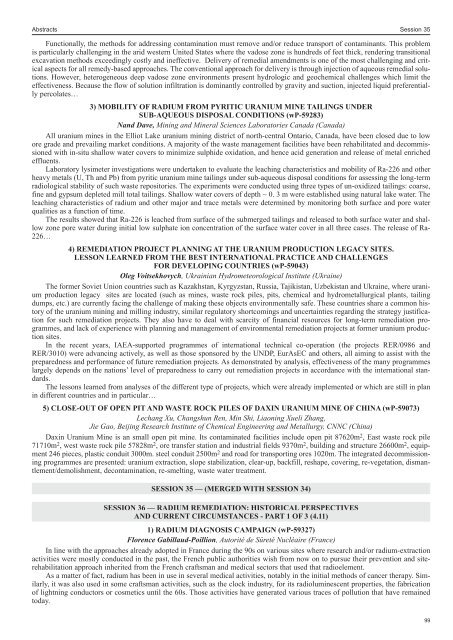ICEM11 Final Program 9.7.11pm_ICEM07 Final Program ... - Events
ICEM11 Final Program 9.7.11pm_ICEM07 Final Program ... - Events
ICEM11 Final Program 9.7.11pm_ICEM07 Final Program ... - Events
You also want an ePaper? Increase the reach of your titles
YUMPU automatically turns print PDFs into web optimized ePapers that Google loves.
Abstracts Session 35<br />
Functionally, the methods for addressing contamination must remove and/or reduce transport of contaminants. This problem<br />
is particularly challenging in the arid western United States where the vadose zone is hundreds of feet thick, rendering transitional<br />
excavation methods exceedingly costly and ineffective. Delivery of remedial amendments is one of the most challenging and critical<br />
aspects for all remedy-based approaches. The conventional approach for delivery is through injection of aqueous remedial solutions.<br />
However, heterogeneous deep vadose zone environments present hydrologic and geochemical challenges which limit the<br />
effectiveness. Because the flow of solution infiltration is dominantly controlled by gravity and suction, injected liquid preferentially<br />
percolates…<br />
3) MOBILITY OF RADIUM FROM PYRITIC URANIUM MINE TAILINGS UNDER<br />
SUB-AQUEOUS DISPOSAL CONDITIONS (wP-59283)<br />
Nand Dave, Mining and Mineral Sciences Laboratories Canada (Canada)<br />
All uranium mines in the Elliot Lake uranium mining district of north-central Ontario, Canada, have been closed due to low<br />
ore grade and prevailing market conditions. A majority of the waste management facilities have been rehabilitated and decommissioned<br />
with in-situ shallow water covers to minimize sulphide oxidation, and hence acid generation and release of metal enriched<br />
effluents.<br />
Laboratory lysimeter investigations were undertaken to evaluate the leaching characteristics and mobility of Ra-226 and other<br />
heavy metals (U, Th and Pb) from pyritic uranium mine tailings under sub-aqueous disposal conditions for assessing the long-term<br />
radiological stability of such waste repositories. The experiments were conducted using three types of un-oxidized tailings: coarse,<br />
fine and gypsum depleted mill total tailings. Shallow water covers of depth ~ 0. 3 m were established using natural lake water. The<br />
leaching characteristics of radium and other major and trace metals were determined by monitoring both surface and pore water<br />
qualities as a function of time.<br />
The results showed that Ra-226 is leached from surface of the submerged tailings and released to both surface water and shallow<br />
zone pore water during initial low sulphate ion concentration of the surface water cover in all three cases. The release of Ra-<br />
226…<br />
4) REMEDIATION PROJECT PLANNING AT THE URANIUM PRODUCTION LEGACY SITES.<br />
LESSON LEARNED FROM THE BEST INTERNATIONAL PRACTICE AND CHALLENGES<br />
FOR DEVELOPING COUNTRIES (wP-59043)<br />
Oleg Voitsekhovych, Ukrainian Hydrometeorological Institute (Ukraine)<br />
The former Soviet Union countries such as Kazakhstan, Kyrgyzstan, Russia, Tajikistan, Uzbekistan and Ukraine, where uranium<br />
production legacy sites are located (such as mines, waste rock piles, pits, chemical and hydrometallurgical plants, tailing<br />
dumps, etc.) are currently facing the challenge of making these objects environmentally safe. These countries share a common history<br />
of the uranium mining and milling industry, similar regulatory shortcomings and uncertainties regarding the strategy justification<br />
for such remediation projects. They also have to deal with scarcity of financial resources for long-term remediation programmes,<br />
and lack of experience with planning and management of environmental remediation projects at former uranium production<br />
sites.<br />
In the recent years, IAEA-supported programmes of international technical co-operation (the projects RER/0986 and<br />
RER/3010) were advancing actively, as well as those sponsored by the UNDP, EurAsEC and others, all aiming to assist with the<br />
preparedness and performance of future remediation projects. As demonstrated by analysis, effectiveness of the many programmes<br />
largely depends on the nations’ level of preparedness to carry out remediation projects in accordance with the international standards.<br />
The lessons learned from analyses of the different type of projects, which were already implemented or which are still in plan<br />
in different countries and in particular…<br />
5) CLOSE-OUT OF OPEN PIT AND WASTE ROCK PILES OF DAXIN URANIUM MINE OF CHINA (wP-59073)<br />
Lechang Xu, Changshun Ren, Min Shi, Liaoning Xueli Zhang,<br />
Jie Gao, Beijing Research Institute of Chemical Engineering and Metallurgy, CNNC (China)<br />
Daxin Uranium Mine is an small open pit mine. Its contaminated facilities include open pit 87620m2 , East waste rock pile<br />
71710m2 , west waste rock pile 57828m2 , ore transfer station and industrial fields 9370m2 , building and structure 26600m2 , equipment<br />
246 pieces, plastic conduit 3000m. steel conduit 2500m2 and road for transporting ores 1020m. The integrated decommissioning<br />
programmes are presented: uranium extraction, slope stabilization, clear-up, backfill, reshape, covering, re-vegetation, dismantlement/demolishment,<br />
decontamination, re-smelting, waste water treatment.<br />
SESSION 35 — (MERGED WITH SESSION 34)<br />
SESSION 36 — RADIUM REMEDIATION: HISTORICAL PERSPECTIVES<br />
AND CURRENT CIRCUMSTANCES - PART 1 OF 3 (4.11)<br />
1) RADIUM DIAGNOSIS CAMPAIGN (wP-59327)<br />
Florence Gabillaud-Poillion, Autorité de Sûreté Nucléaire (France)<br />
In line with the approaches already adopted in France during the 90s on various sites where research and/or radium-extraction<br />
activities were mostly conducted in the past, the French public authorities wish from now on to pursue their prevention and siterehabilitation<br />
approach inherited from the French craftsman and medical sectors that used that radioelement.<br />
As a matter of fact, radium has been in use in several medical activities, notably in the initial methods of cancer therapy. Similarly,<br />
it was also used in some craftsman activities, such as the clock industry, for its radioluminescent properties, the fabrication<br />
of lightning conductors or cosmetics until the 60s. Those activities have generated various traces of pollution that have remained<br />
today.<br />
99
















